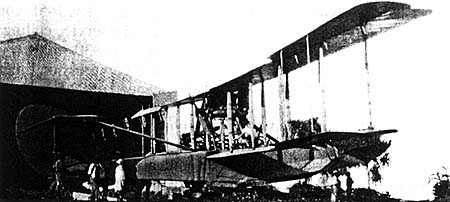PHILIPPINE
AIR SERVICE
1920 - 1921

An
Air Service Seagull completely assembled and being moved
to
the beach runway for its test flight.
Governor
General Harrison took this opportunity for celebration to congratulate
personally the Curtiss instructors and their pupils on "the remarkable
progress that had been achieved during the months of patient devotion to
duty." He said that "to the best of his information, a record had been
achieved in the time in which the instruction had been completed and the
necessary skill to qualify as aviator had been acquired."
Graduating
cadets were rated and ranked in their class based upon "their ability as
flyers and also their efficiency in airplane mechanics, navigation, radio
work, conduct, and probable efficiency." The top six cadets, in the order
of their class ranking, were Lieutenants P.E. Zablan, Ignacio P. Perez,
Juan Calvo, Captain Faustino Reyes, Lieutenants Leoncio B. Malinao, and
Basilio Femando. They were among those who qualified to fly both the JN-4D
Jenny and the HS-IL/2L Seagull. The remaining cadets rated to fly both
the Jenny and Seagull were Pedro Dimaguila, Arturo Maglaya, Felix C. Reyes,
Osmundo C. Ramos, Victor Real and Mariano Rueda. Twelve pilots qualified
for only land based aircraft and these included Cadets Carlos A. Barretto,
Juan P. Villasanta, Fabian 0. Bugarin, Wenceslao Abolencia, Miguel Aguinaldo,
Donate M. Halili, Salvador Medialdea, Donate M. Halili, Alfonso de Guzman,
Jose Padilla, Eduardo Montilla, Alonso Gatuslao and Ramon Banez.
It
is worth mentioning that out of an original class of 30 military cadets
that began flight training, 25 graduated. There were no fatalities in the
training and only a handful of accidents where aircraft were damaged in
takeoffs and landings. The most notable involved one of the HS-2L Seagulls
damaging a wing by hitting a partially submerged obstruction in Manila
Bay. This success, rate exceeds many of the flight training classes during
World War I and later during World War II.
In
less than a month's time from receiving their pilot wings, the first Philippine
Air Service pilots began ranging out from Manila in the HS-2Ls to build
up the proficiency, flight time, and experience that they would ultimately
need to fly passengers and mail between the islands.
In
February 1921, the Militia Commission that governed the Philippine Air
Service approved the payment of 48,000 pesos to the Curtiss School of Aviation
for the training of the recently graduated pilots. At the same time, the
commission created several key posts within the fledgling Philippine Air
Service that would be responsible for the management and operations. Captain
Barretto was named Technical Director. Thomas R. McComas as Chief Flight
Engineer and Leoncio B. Malinao, P.E. Zablan, Basilio Femando. Faustino
Reyes, Juan Calvo and Ignacio Perez as pilots. In an effort to build public
awareness and support for the Air Service, the Militia Commission authorized
the Philippine Air Service to fly exhibition flights over the Carnival
at Lopez and Tayabas. The remaining graduates returned to active duty in
their former Constabulary and National Guard units until the Air Service
had an opportunity to expand, thereupon they would be called up based upon
their graduation rating.
During
this time, the Philippine Air Service attempted to sway public opinion
in favor of this new form of transportation. Special exhibition flights
were approved to attend the Lingayen and Vigan Carnival festivities. Pilots
would fly awe-inspiring demonstrations, including stalls, spirals, slips,
tailspins and loops for audiences that included the public, local business
leaders, and government officials. While on the ground, the pilots met
with community and government leaders, and served as goodwill ambassadors,
stressing the economic advantages of the Air Service to the public and
to local commerce.
Despite
the enthusiastic reception and support at every aerial demonstration, translating
that support into commercial use of the Air Service was slow.
Later
that month, the Philippine Assembly approved the funding of the Philippine
Air Service with the General Appropriations Act of 1921 which funded the
expenses of the Philippine Air Service and authorized an additional expense
of 645,000 pesos for the purchase of land for the creation of an Insular
airport.
The
Assembly also approved a resolution put forward by Representative Leuterio,
a member of the Militia
Commission,
that the "Philippine Air Service has been created for the carriage of passengers,
air mail service and for the air defense" of the Philippine Islands. |

